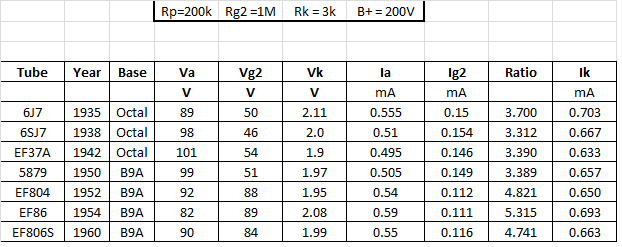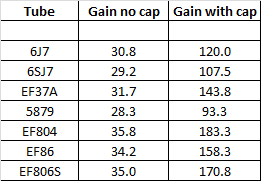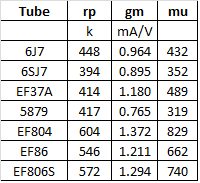Ever since I read a post by Ian (ruffrecords) about noise, I have been looking at the problem in pentodes.
Some of the early theories about noise in pentodes have been challenged recently, and an article in Linear Audio by Frank Blohbaum showed how it was possible to recombine the screen grid current with the plate current to neutralise partition noise, by using a second device. I may get around to testing that myself one day, but I thought I'd share some data I produced first.
The partition noise is caused by the splitting of the cathode current between the plate and g2, so by reducing the G2 current we should minimise the noise. The stuff on forums often says a 6J7 is a 6SJ7 is an EF86 and so on, but I have just found that is not true at all. They have different internal dimensions which do not allow you to vary the respective currents at will as this table shows:-

I carefully set up an experiment with exactly 6.3V of DC on the heaters and exactly 200V for the B+.
I used the values for the V76 mic pre because they are pretty much optimal, but I had both plate and G2 resistors at 200V, not as in the V76.
What is immediately obvious is that the screen current has been reduced over time to reduce the partition noise, and the ratio has gone up. This is one of the keys to a low noise pentode. I was unable to adjust the earlier tubes to get anywhere near that later ratio.
The gain under the same conditions is in this table:-

Admittedly, these are only single samples of NOS tubes but there is no way these can all be considered to be equivalent .
I hope you find this data helpful in future projects
Best
DaveP
Some of the early theories about noise in pentodes have been challenged recently, and an article in Linear Audio by Frank Blohbaum showed how it was possible to recombine the screen grid current with the plate current to neutralise partition noise, by using a second device. I may get around to testing that myself one day, but I thought I'd share some data I produced first.
The partition noise is caused by the splitting of the cathode current between the plate and g2, so by reducing the G2 current we should minimise the noise. The stuff on forums often says a 6J7 is a 6SJ7 is an EF86 and so on, but I have just found that is not true at all. They have different internal dimensions which do not allow you to vary the respective currents at will as this table shows:-

I carefully set up an experiment with exactly 6.3V of DC on the heaters and exactly 200V for the B+.
I used the values for the V76 mic pre because they are pretty much optimal, but I had both plate and G2 resistors at 200V, not as in the V76.
What is immediately obvious is that the screen current has been reduced over time to reduce the partition noise, and the ratio has gone up. This is one of the keys to a low noise pentode. I was unable to adjust the earlier tubes to get anywhere near that later ratio.
The gain under the same conditions is in this table:-

Admittedly, these are only single samples of NOS tubes but there is no way these can all be considered to be equivalent .
I hope you find this data helpful in future projects
Best
DaveP


























![Electronics Soldering Iron Kit, [Upgraded] Soldering Iron 110V 90W LCD Digital Portable Soldering Kit 180-480℃(356-896℉), Welding Tool with ON/OFF Switch, Auto-sleep, Thermostatic Design](https://m.media-amazon.com/images/I/41gRDnlyfJS._SL500_.jpg)







